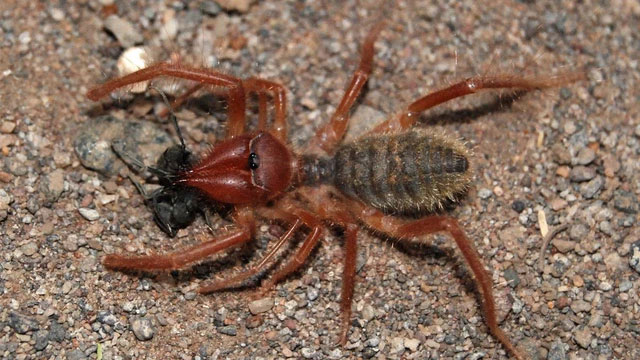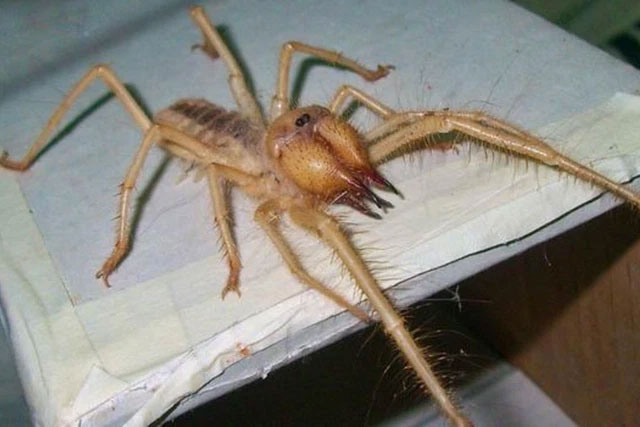Camel Spider - The Scariest Predator of the Desert
The camel spider is a described species of large, ugly appearance and is the subject of many sublime stories. The myths surrounding the creature became widespread in 2003, at the height of the Iraq war, when American soldiers began to discover their scrawny bodies in the deserts of the Middle East.
Before it became known to the US military, however, the creature was the subject of many fables told by the Persians, who saw it for the first time. But despite their intimidating appearance, camel spiders (which are not actually spiders) are harmless to humans. Moreover, it only lives for a year in the wild and spends most of its time hiding, hiding from the blazing sun in the desert.

Camel spiders are not actual spiders or scorpions.
Camels aren't really spiders
The camel spider is actually a species of the class Arachnida (spider-shaped class) and is correctly called with the scientific name Solifugae. This order includes more than 1,000 described species in about 153 genera.
Despite the common names, they are not true scorpions (of the order Scorpions) and are not true spiders (of the order Araneae). Instead, they are cousins to pseudoscorpions and mites.
According to National Geographic, the Persians often told stories of this terrifying-looking creature standing tall, running through the desert like a whirlwind, hunting for human corpses and camels that dared to cross. its path. However, this is not entirely true. Camel spiders do not eat humans, camels or any other large mammal.
Instead, the solifugae - sometimes called the wind scorpion or the sun spider - is only about 15 centimeters long as an adult. And despite exaggerated stories of its 'fast and furious' speed, its top speed is 10 miles per hour - just slightly faster than the average human.

Most species of the order Solifugae live in arid climates and hunt terrestrial arthropods and other small animals. The largest species is 12–15 cm in length, including the legs. Some urban legends exaggerate the size and speed of the Solifugae, however their potential danger to humans is negligible. But also absolutely not to be disregarded and should be handled appropriately when encountering this spider.
Camel spiders have a voracious nature
Several reviews of the solifugae diet by the Denver Museum of Nature and Science found that camel spiders enjoyed eating wasps, termites, beetles, and other arthropods.
However, they can hunt small birds and even small snakes. If given the opportunity, it will eat until its belly swells - often becoming so large that it cannot move, especially if it eats too quickly. As a general rule, however, wind scorpions will not eat prey larger than themselves.
In fact, this creature has a rather aggressive personality - especially if it feels cornered or threatened. Although it has no venom glands, camel spiders have sharp pincer teeth called chelicerae that will cause damage if it comes into contact with human skin.
And although camel spider bites don't require medical attention to heal, it's a good idea to rinse the bite with alcohol or hydrogen peroxide to prevent infection, in case it bites you. But, as a general rule: if you leave it alone, it will leave you alone.

Although the order Solifugae are considered endemic indicators of desert biomes, they occur widely in semi-deserts and woodlands. Some species also live in grasslands or forest habitats. Solifugae are found in warm and arid habitats, including virtually all warm deserts and shrublands on all continents except Antarctica and Australia. Solifugae are carnivores or omnivores, with most species feeding on termites, beetles, and other small terrestrial arthropods. Solifuge are aggressive predators and opportunistic voracious eaters and have been recorded to have eaten snakes, small lizards, birds, and rodents.

Prey is located by the front pair of limbs, killed and cut into pieces by the pincer-like claws. The prey is then liquefied and the ingested liquid passes through the pharynx. Although they do not usually attack humans, their pincer claws can puncture human skin and painful bites have been reported. Many other predators, such as large slit-faced bats, scorpions, toads, and insectivores, can hunt Solifugae. Solifugae is usually a species that breeds once a year. The female, after obtaining the male's sperm, will dig a burrow in which she lays 50 to 200 eggs.

Camel spiders were well known during the 1990-1991 Gulf War, and became famous when American soldiers arrived in Iraq.
- Huge hairy spider in the desert
- Explore the mystery of the camel's hump
- The cutest contest in the world
- The robot spider can bend and bend like a desert spider in Africa
- Tiny spider launching
- 'Six-eyed monster' and venom cause people to burst into blood vessels
- Recreate the 410 million-year-old spider's walking
- The 10 scariest assassins in the ocean
- The little things people know about spiders
- Few people think this camel is the source of the world's rarest fiber fabric
- The world's first human camel was born
- Video: The reason why camel milk is like 'white gold'
 Animal 'suffering' after hibernation
Animal 'suffering' after hibernation Why do goats climb well?
Why do goats climb well? Scientists were surprised to see chimpanzees eating turtles
Scientists were surprised to see chimpanzees eating turtles Giant catfish died deadly due to drought in Thailand
Giant catfish died deadly due to drought in Thailand